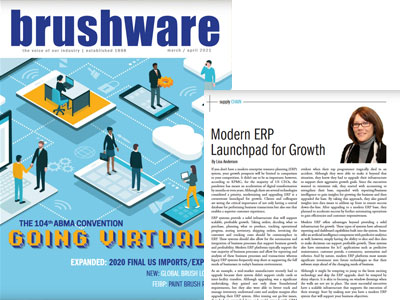If you don’t have a modern ERP system, your growth prospects will be limited in comparison to your competition. It didn’t used to be as important; however, according to KPMG, for the majority of U.S. CEOs, the pandemic has meant an acceleration of digital transformation by months or even years. Although there are several technologies considered a priority, modernizing and upgrading ERP is a cornerstone launchpad for growth. Clients and colleagues are seeing the critical importance of not only having a central database for performing business transactions but also one that enables a superior customer experience.
ERP systems provide a solid infrastructure which will support scalable, profitable growth. Taking orders, deciding what to purchase, planning what to produce, tracking operational progress, storing inventory, shipping orders, invoicing the customer and tracking costs should be commonplace in ERP. These systems should also allow for the automation and integration of business processes that support business growth and profitability. Modern ERP systems typically support the vast majority of business processes and allow for reporting and analysis of these business processes and transactions whereas legacy ERP frequently stop short at supporting the full needs of businesses in today’s business environment.
For example, a mid-market manufacturer had to upgrade because their system didn’t support credit cards or inter facility transfers. Although upgrading was a significant undertaking, they gained not only these foundational requirements, but they also were able to better track and manage inventory, understand costs and analyze margins after upgrading their ERP system. After ironing out go-live issues, they had an upgraded base and could expand with CRM (customer relationship management) capabilities as well as B2B/ B2C and e-commerce functionality so that they could grow the business successfully.
In another manufacturer, they had a highly customized ERP system that supported their current needs expertly; however, it didn’t support scalable growth. It was also highly dependent on programmers with specialized knowledge. This risk became evident when their top programmer tragically died in an accident. Although they were able to make it beyond that situation, they knew they had to upgrade their infrastructure to support their aggressive growth goals. Since the executives wanted to minimize risk, they started with accounting to strengthen their base, expanded with reporting/ business intelligence to gain insights for growing the business and then upgraded the base. By taking this approach, they also gained insights into data issues to address upfront to ensure success down-the-line. After upgrading to a modern ERP base, they planned to accelerate success by further automating operations to gain efficiencies and customer responsiveness.
Modern ERP offers advantages beyond providing a solid infrastructure for growth. These types of systems have advanced reporting and dashboard capabilities built into the system. Some offer an artificial intelligence component with predictive analytics as well; however, simply having the ability to slice and dice data to make decisions can support profitable growth. These systems also have extensions for IoT applications such as predictive maintenance, customer portals and e-commerce, and automation and robotics. There is significant investment into future technologies so that the software stays ahead of the changing needs of the business.
Although it might be tempting to jump to the latest exciting technology and skip the ERP upgrade, don’t be tempted by shiny objects. It is akin to focusing on window dressings when the walls are not yet in place. The most successful executives have a scalable infrastructure that supports the execution of their strategy. Start by making sure you have a modern ERP system that will support your business objectives.
As originally published in Brushware Magazine on March 2021



